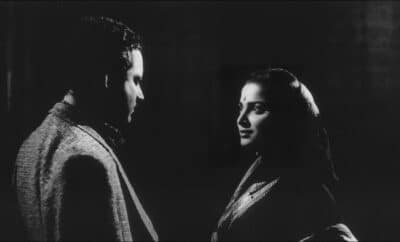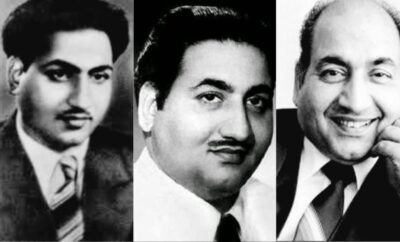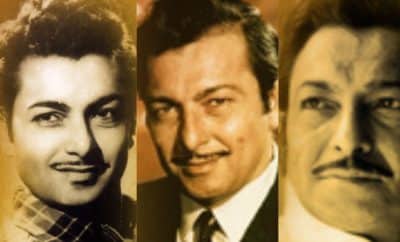Song Sketch
Proud Indians, Are We? – Jinhe Naaz Hai Hind Par – Pyaasa
A man clearly ahead of his time, Guru Dutt, made less than 50 films in his lifetime. His life which was enveloped by tragedy, overshadowed his career. Guru Dutt’s style of filmmaking was very contemporary. His movies dealt with a wide range of subjects such as love, poverty, unemployment, equality & social values. His cinematic perceptions haven’t yet found a match. A man who brought out the best in a scene without saying a word. Pyaasa (1957) is the best example of his workmanship. A film which was included in the list of the most romantic films in 2011. Sensitive, Poetic, Magical – this is what Pyasa is!! Rightly so, in Sathya Saran’s book – Ten Years With Guru Dutt: Abrar Alvi’s Journey – it says – Guru Dutt is probably the only Indian film-maker who, within the parameters of the box office, made a personal statement with his cinema. His films stand testimony not only to his own genius but also to the creativity of his team, comprising stalwarts like cameraman V.K. Murthy, music director S.D. Burman, and writer Abrar Alvi, among others.
In Ten Years with Guru Dutt: Abrar Alvi’s Journey, Sathya Saran looks at the tumultuous yet incredibly fecund relationship between the mercurial director and his equally talented albeit unsung writer, a partnership that evolved over a decade till Guru Dutt’s tragic death in 1964. Starting his career as a driver and chaperone to Guru Dutt’s producer on the sets of Baaz, Abrar soon caught the attention of the director with his sharp ear for and understanding of film dialogue.
With Aar Paar in 1954, Abrar rewrote the rules of dialogue-writing in Hindi cinema, till then marked by theatricality and artificiality. He followed it up with masterpieces like Mr and Mrs 55, Pyaasa and Kaagaz Ke Phool, before donning the director’s mantle with great success in Sahib Bibi Aur Ghulam. Pyaasa, according to this book, was supposedly a story based on the red light area. With Guru Dutt as the male lead and director and Abrar Alvi as the scriptwriter and screenplay writer. Both of them were involved in extensive research for the subject. As a part of their research, it was decided that they visit a red light area, observe the atmosphere and the finer nuances and bring it out on the big screen through the film. A famous red light area of Kolkata was chosen and both of them visited the area hiding their identity. They began noting down all that was required for the film. One of the halls in the area had come alive with excitement, since the mujra was about to be performed. Guru Dutt and Abrar Alvi chose a distant corner of the hall to watch the performance. A young beautiful lady, who was sitting in the middle of the hall, started to sing with the people around passing comments. After a while she got and started to dance but she missed a few steps, coughed in between and was getting little breathless. And that was the time when Guru Dutt realised that she was pregnant. People around were paying no heed to her plight were looking forward to some more performances from her and she was doing so for just a small amount of money. Guru Dutt could feel the oppression, the compulsion, that young lady was facing. The sensitive Guru Dutt could not bear it any longer. He offered a bundle of notes to the lady and left the place instantly. Guru Dutt was swamped with emotions. He portrayed these feelings through a heart wrenching song in Pyaasa.
Jinhe naaz hai Hind par wo kahan hain….
With Sahir Ludhianvi’s lyrics befitting his emotions, Rafi’s soft yet contemplating voice rendering to S D Burman’s music. The song was initially recorded on Guru Dutt’s private recorder. S D Burman has used only guitar strums throughout the song which gives it a haunting effect.
The song which originally is a nazm called Chaklay by Sahir Ludhianvi, was used with some modified lyrics in the film to suit the situation. It was written as voice against Nehru post independence.
The original nazm Chaklay –
Ye Kooche Ye Neelaam-Ghar Dil-Kashi Ke
Ye Lutate Hue Kaarvaan Zindagi Ke
Kahaan Hain Kahaan Hain Muhaafiz Khudi Ke
Sanaa-Khwaan-E-Taqdees-E-Mashriq Kahaan Hain
Ye Pur-Pench Galiyaan Ye Be-Khwaab Baazaar
Ye Gumnaam Raahi Ye Sikkon Ki Jhankaar
Ye Ismat Ke Saude Ye Saudon Pe Takraar
Sana- Khwaan-E-Taqdees-E-Mashriq Kahaan Hain
Ta’ffun Se Pur Neem-Raushan Ye Galiyaan
Ye Masli Hui Adh-Khuli Zard Kaliyaan
Ye Bikti Hui Khokhli Rang-Raliyaan
Sana-Khwaan-E-Taqdees-E-Mashriq Kahaan Hain
Wo Ujle Dareechon Mein Paayal Ki Chhan-Chhan
Tanaffus Ki Ulajhan Pe Tabale Ki Dhan-Dhan
Ye Be-Rooh Kamron Mein Khaansi Ki Dhan-Dhan
Sanaa Khwaan-E-Taqdees-E-Mashriq Kahaan Hain
Ye Goonje Huwe Qah-Qahe Raaston Par
Ye Chaaron Taraf Bheed Si Khidkiyon Par
Ye Aawaazen Khinchte Huwe Aanchalon Par
Sana-Khwaan-E-Taqdees-E-Mashriq Kahaan Hain
Ye Phoolon Ke Gajre, Ye Peekon Ke Chheente
Ye Be-Baak Nazaren, Ye Gustaakh Fiqre
Ye Dhalke Badan Aur Ye Madqooq Chehre
Sana-Khwaan-E-Taqdees-E-Mashriq Kahaan Hain
Ye Bhookhi Nigaahen Haseenon Ki Jaanib
Ye Badhte Huwe Haath Seenon Ki Jaanib
Lapakte Huwe Paanv Zeenon Ki Jaanib
Sana-Khwaan-E-Taqdees-E-Mashriq Kahaan Hain
Yahaan Peer Bhi Aa Chuke Hain Jawaan Bhi
Tano-Mand Bete Bhi, Abbaa Miyaan Bhi
Ye Beewi Bhi Hai Aur Bahan Bhi Hai, Maan Bhi
Sana-Khwaan-E-Taqdees-E-Mashriq Kahaan Hain
Madad Chaahti Hai Ye Hawwa Ki Beti
Yashodha Ki Ham Jins Raadha Ki Beti
Payambar Ki Ummat Zulaikha Ki Beti
Sana-Khwaan-E-Taqdees-E-Mashriq Kahaan Hain
Zara Mulk Ke Rah-Baron Ko Bulaao
Ye Galiyaan Ye Kooche Ye Manzar Dikhaao
Sana-Khwaan-E-Taqdees-E-Mashriq Ko Laao
Sana-Khwaan-E-Taqdees-E-Mashriq Kahaan Hain
Now if you hear the lyrics of this song, you will understand the profundity and insight of these artists. Try to go through the song lyrics keeping Guru Dutt’s situation in mind. How beautifully it has been expressed!!
The song lyrics –
Ye kooche ye nilaam ghar dilkashi ke
Ye lutate huye caravan zindagi ke
Kahaan hain kahan hain muhafiz khudi ke
Jinhe naaz hai hind par wo kahaan hain
Kahaan hain kahaan hain kahaan hain
Look at these lanes, alluring houses which are up for sale/auction everyday. Look at these robbed caravans of life. Where are those protectors of self respect and pride? Where are those who say we are proud Indians? What are you exactly proud of?
Ye purpech galiyaan ye badnaam bazaar
Ye gumnaam raahi ye sikkon ki jhankaar
Ye ismat ke saude ye saudon pe taqraar
Jinhe naaz hai hind par wo kahaan hain
Kahaan hain kahaan hain kahaan hain
These complicated streets, these defamed, scandalized markets. The unknown pedestrians who walk in anytime with bagful of money. This trade of honour and chastity followed by the bargains of the same. Are we Indians proud for this? Where are those who say this?
Ye sadiyon se bekhauf sehmi si galiyaan
Ye masli huyi adhkhili zard kaliyaan
Ye bikti huyi khokhli rangraliyaan
Jinhe naaz hai hind par wo kahaan hain
Kahaan hain kahaan hain kahaan hain
These lanes which for years have been under pressure of fear, distress, angst. This place where the pale half blossomed buds are crushed (referring to young girls who fall prey to the flesh trade). The hollow festivities which are sold in this market. Show all this to those who say, they are proud of this country. Where are those people?
Wo ujle darichon mein paayal ki chhan chhan
Thaki haari saanson pe table ki dhandhan
Ye berooh kamron mein khaansi ki thanthan
Jinhe naaz hai hind par wo kahaan hain
Kahaan hain kahaan hain kahaan hain
The sound of the trinkets, anklets which come from the shimmering windows. Those tired, ill heartbeats which try to keep pace with the pace. This soul less room which filled with the unpleasant sound of coughing. For those who say they are proud Indians, please come and see this.
Ye phoolon ke gajre ye pikon ke chhinte
Ye bebaak nazrein ye gustaakh fiqrein
Ye dhalke badan aur ye bimar chehre
Jinhe naaz hai hind par wo kahaan hain
Kahaan hain kahaan hain kahaan hain
The flowers, the garlands, the stains of betel juice. The bold stares, the blunt, audacious comments. The deteriorating, decaying bodies and weak faces. Look at them, those who say, they are proud of their country.
Yahan piir bhi aa chuke hain jawaan bhi
Tanaumand bete bhi abba miyaan bhi
Ye biwi bhi hai aur behan bhi hai maa bhi
Jinhe naaz hai hind par wo kahaan hain
Kahaan hain kahaan hain kahaan hain
The ambassadors of religion, the young and the old, the sons and the fathers, all are regular visitors to this place. Here you will find someone’s wife, someone’s sister or mother too. Come and have a look at this place. Will this place make you proud?
Madad chaahti hai ye hawwa ki beti
Yashoda ki hamjins Radha ki beti
Payambar ki ummat Zulaykha ki beti
Jinhe naaz hai hind par wo kahaan hain
Kahaan hain kahaan hain kahaan hain
The girls, women here need help. They are no different from Eve, Yashoda, Radha, Zulaykha who are seen with regard and respect. Come and help them, they need you.
Zara mulk ke rahbaron ko bulaao
Ye kooche ye galiyaan ye manzar dikhaao
Jinhe naaz hai hind par unko laao
Jinhe naaz hai hind par wo kahaan hain
Kahaan hain kahaan hain kahaan hain
Someone please call the so called guides, leaders of the country. Show them these lanes, show them this miserable scene. Call them those who say they are proud of their country. Where are they?
The lyrics make you feel empty inside, hollow. Rafi’s voice tugs at your soul gently. S D Burman’s music – just those haunting strums of guitar. It hauls your heart in shame.
The darkness, the murkiness of the song will make you contemplate on today’s situation too. The situation has worsened so to say. Guru Dutt, Sahir Ludhianvi, S D Burman, Mohammed Rafi and also the anonymous young pregnant lady from the red light area have given us these thoughts to ponder, they are sure to leave a scar on real humans.
https://www.youtube.com/watch?v=3ta4BmumQKc
Cover version of the nazm in Manna Dey’s voice is also as masterly as Rafi’s version –




Pingback: Ae Watan – Filmi andaaz
Urvah
February 15, 2019 at 6:58 pm
Its a very good translation Deepa and thanks for presenting both versions.
Deepa
February 18, 2019 at 6:25 pm
Thank you so much 🙂
R. Kannan
February 26, 2020 at 2:11 am
I was too young to see the movie but heard the songs over the years mostly for Geeta Dutt’s voice and Rafi’s “Jalo Do.” I didn’t know much about the movie or the characters or the real life of the people behind the movie. Two weeks ago I saw the full movie and feel so connected to these words of “Kahan Hai.” I am still wondering where is that Hind that we dreamed of. I am an old man now and still hunger and thirst for righteousness that I have only seen as sparks in one human here and one there, once in a while. Thank you for the translation. It means so much to me.
Thomson Felix
March 27, 2020 at 11:06 am
Thank You Deepa for the trove of Information. Moved by the song. The song is applicable to the entire human race as the emotions are the same across all races and religions. also reminds us that there is nothing to be proud of, when someone in the next street or next door is suffering. Thanks for the Manna dey version
Akshat
July 27, 2023 at 7:21 pm
Thank you so much for the translation.